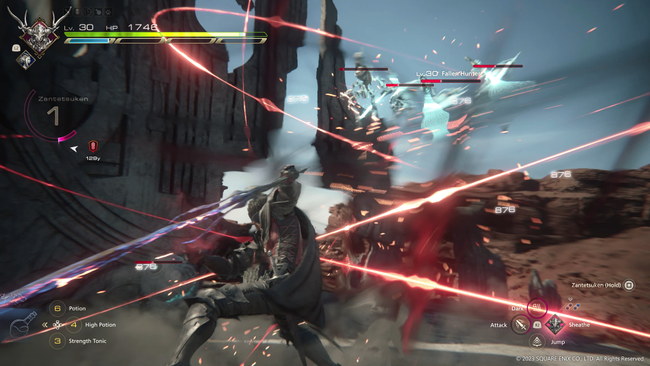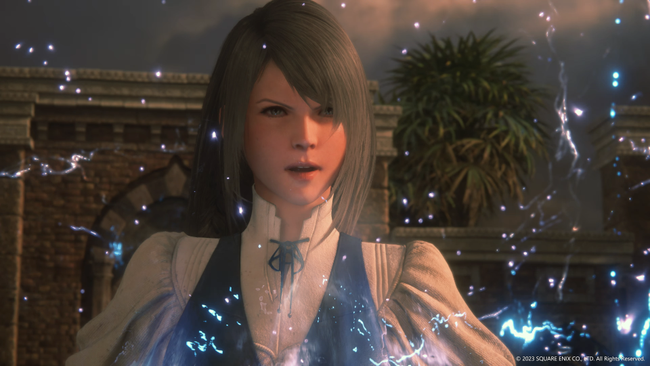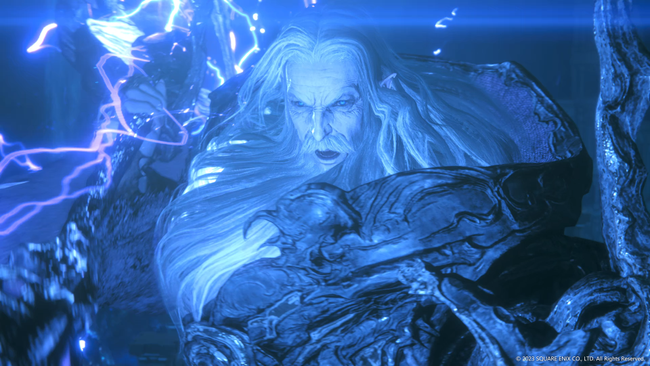
Final Fantasy XVI Non-Spoiler fan FAQ - Your Questions Answered
Final Fantasy XVI is almost upon us - and before lots of of you buy and jump in, we wanted to take the opportunity to answer some burning questions about the nature of this rarest of things - a new numbered, main-line Final Fantasy game!
After taking your questions across the RPG Site social media channels, we’re here to answer your questions - spoiler-free, of course. In these questions, we answer key questions about the game’s structure, our experience with it, and how certain systems work.
The only potential spoiler is we mention a few things that are not in the game - so consider yourself warned. If you want a full verdict on the quality of the final product, be sure to hit up our full FF16 review for a verdict without the Q&A formatting. Now, though, let’s get to your questions:
How many hours to complete the game?
A couple of RPG Site regulars have finished the game pre-release. It took one of us a little bit over 51 hours to hit 100% completion on the initial difficulty mode, including completing all side quests, all hunts, and all combat trials. I imagine if you chose to eschew some or all of the side content, you could be done in around 35 hours.
Cullen, who wrote the actual review here on RPG Site, had a slightly longer play time at somewhere over 60 hours.
All of these are estimates, as for some reason there is no in-game timer showing your total playtime.
Are there cities to explore? How about towns?
The world of FF16 has some significant nations with huge citadels and sprawling capital cities, as shown in trailers - but you shouldn’t expect to explore them in the traditional RPG sense, no.
Spread across the more open zones of the game there are several towns of varying sizes, ranging from tiny hamlets and abandoned remnants to slightly larger, busier towns. All are pretty similar though - each features a shop where you can stock up on consumable items, though aside from collectible music that is playable in your base, few shops carry anything not already available from the shop on your home base.
A couple of the towns have taverns you can enter, both of which are entered as part of the story. Few other buildings can be entered. There’s a lot of ambient dialogue to be heard around, however, and usually a few characters you can directly talk to. Most of the larger towns have a few side quests dedicated to them.
But make no mistake, these are small hamlets made up of small wooden shacks and buildings, not larger-scale settlements. The huge cities and impressive buildings you’ve seen in trailers do appear in FF16, but only in cutscenes and the linear action stages - and usually under threat of destruction, burning and crumbling. Speaking of the action stages…

How much does the world open up in the game?
It depends on how you want to look at it. To be clear, FF16 is basically divided into three sections: First, there’s your home base. Second, there’s linear action stages. Third, there’s ‘open zone’ areas you can return to. You transport between these types of zone via a world map, and the next ‘main mission’ is always highlighted, where heading to that location begins the next linear action stage.
The action stages play like levels in titles like Devil May Cry, with a clear beginning, middle, and end. These zones are linear, with only minor distractions off the narrow, beaten path, and don’t even have a map.
There’s four open zones, each covering a distinct kingdom and the surrounding areas, complete usually with a few towns (either populated or abandoned) and other points of interest, plus fast travel locations. The topography of these zones varies, but they’re generally larger areas strung together by narrow pathways made up of forests, ravines, trenches cut into mountains, and so on. Enemies litter these zones, plus occasional NPCs out in the wilds. These zones are also where you can ride a Chocobo, once unlocked.
They’re most similar to the areas found in FF12, but another good comparison would be how Midgar feels towards the end of FF7 Remake when you have access to all of the slums for a sidequest bonanza before that game’s point of no return. .
Strangely, these open zones have a map in the menu, but no mini map or compass outside of it, which can be a bit frustrating.
Structurally, the game is actually quite similar to the ‘golden age’ BioWare RPGs. To draw a comparison to Mass Effect, Clive’s Hideaway is his Normandy, complete with shops, friendly NPCs, and even a captain’s cabin of a sort. From there, you can head out to revisitable open zones, or one-off narrative rollercoaster missions.
How are the side quests? How does doing them impact the story pacing?
Honestly, this is probably one of the weaker elements of the game, though there are some gems in here. First of all, side quests are basically split into three categories - similar, in fact, to FF14.
Standard side quests are represented with one icon, and they provide basic rewards. The best reward, in fact, is usually the tidbits of world building and story that comes from engaging with the quests. A second stripe of side quests is marked with a Plus icon, and these represent quests that unlock something significant, such as an increase to your potion storage, some new crafting recipes, or even access to a Chocobo.
Side quest objectives are generally just to speak to NPCs, to kill some stuff, or to pick something up from somewhere else and deliver it. Usually any given quest is two or more of these objectives rolled up together. The rewards are pretty meager, but the thing that’ll make you want to engage with the quests is the story attached to them and how they flesh out the characters and world.
In terms of how it changes the pacing - FF16 is definitely a game that deliberately ramps up to high speed for its big set pieces and then slows right down for a breather afterwards, and the way and time batches of side quests are introduced is built to match up to that pace.
In case anyone is curious, the side quests take place either in your hideout, or across the four larger ‘open zone’ maps - there aren’t any ‘optional dungeons’ or anything to that effect.
Finally, there’s hunts - which get posted to a board in the hideout periodically and can be tracked down in the open zone areas.

How does magic damage work? Or magic generally? I saw some of the demo where Clive uses Fire but he doesn't have a separate magic stat.
The short version of this answer is that there is no traditional elemental magic system in FF16. That’s why there’s no separate magic stat.
Here’s how it works: Clive can equip up to three Eikons (that’s the summons), and you can cycle between which Eikon he’s currently using with L2. Which Eikon he’s using determines which ‘magic attack’ is on the triangle button.
So with Shiva equipped, it’ll be Ice magic. With Ifrit, Fire, and so on. However, all of these attacks are basically only different visually - they all function the same, and there’s no elemental strengths and weaknesses involved. So switching to Ifrit and using its magic bursts against an icy enemy doesn’t do any additional damage. Really, the magic bursts assigned to the Triangle button is functionally Clive’s version of the pistols in Devil May Cry - a ranged option to keep up the pressure.
In addition, the Eikon’s abilities and skills are often considered magic - so Shvia’s Diamond Dust is naturally considered Ice magic, for instance.
Why does this matter if there’s no elemental resistance? Well, certain enemies will cast Protect on their allies - and when this happens, they obtain a shield that cannot be broken with physical attacks. You have to hit the shield with magic - of any element - to shatter it, and can then resume your normal comboing. But really, that’s the most separate magic gets - otherwise it just forms part of combos as your most flashy moves.
Is performance mode fixed?
The short answer is no, even after the day one patch. But we aren’t hardcore hardware and performance experts - so we hand this answer over to friend of the site John Linneman of Digital Foundry, who can speak on this with way more authority. Over to John:
“Both before and after the patch, performance mode issues persist. Poor image quality is combined with a highly unstable frame rate that regularly falls outside the PS5's VRR window, resulting in noticeable judder.
Battles perform reasonably well, but exploration scenes struggle throughout the game. I'd recommend playing on quality mode; it's clearly what the developers intended.”
Is it just weapons that change looks or can you see any of the armor pieces you can equip?
Only Clive’s weapon changes appearance; the other equipment is not reflected on his character model. Clive has a couple of different hero outfits during the game, and you will have seen both looks in pre-release material.
Can you alter/choose Torgal’s abilities in any way, either through a system similar to the skill tree for the MC or through some other mechanism?
Torgal is Torgal; his skill set doesn’t really change. Functionally he’s an ally that can be ordered to attack enemies, and you can use him to do things like keep an enemy in hitstun or a juggle state to allow for more complicated and lengthy combos.
There’s no menu-related or equipment options for Torgal, save for a few accessories that you can equip to Clive that increase his potency. Torgal does have one ‘combat upgrade’ that occurs as part of a story event, but from the point it unlocks it seemingly only triggers at random, with no player control over it.

Will we fight super bosses?
What we don’t know is what lies in the end game of New Game Plus, as none of the RPG Site team who’ve played the game have gotten that deep into NG+.
In the main initial difficulty mode, the only super enemy element is the hunts. There's over 30 hunts unlocked over the course of an initial save 100% playthrough. Hunts are ranked C-S, and there are a handful of S-Rank hunts, which are some of the hardest encounters in the game.
Hunts generally unlock the crafting materials required to unlock the best weapon in the game - though there is an even more powerful weapon available in NG+. So it seems safe to imagine there will be at least one more extra Hunt that drops extra materials in that mode.
The main thing I'm still wondering about is the degree to which it "feels" like a Final Fantasy. I know that's hard to quantify but it's my biggest question going in!
It does feel like Final Fantasy - but I’d say it’s a feeling that ramps up over the course of the game. Early on, it feels like aside from the summons and a few familiar monsters, the developers didn’t want to get too bogged down in FF stuff. But as the game, world, and story develops, it definitely tends to trend back towards more traditional FF stuff. It begins to lean on stuff like the power of friendships in an epic gods-and-monsters struggle.
Earlier on, however, it’s definitely more grounded in that Game of Thrones kingdoms at war thing. And I have no doubt some FF fans are going to be slightly put off by how bloody and brutal it is - no game in this series has been quite like this, not even in Ivalice. The longer the story goes on, however, the more it feels like it happily shifts back towards more familiar territory to FF fans.
Masayoshi Soken does a great job of bringing more of an FF feel throughout with the music, though. There’s some wonderful cuts, mostly from the first FF game - I never knew a somber, minor key, marching version of FF1’s world map theme could be effective, but it is.
Are there any Queen references? It's not a Matsuno game without Queen references.
Not that we saw - but this is also not a Matsuno game! While FF16 clearly owes a heavy debt to Tactics, FF12, and Ivalice, Yasumi Matsuno is not part of the FF16 development team.
The trophies and side quest names are packed with references to other FFs and pop culture at large - referencing everything from classic 80s movies to Alice in Wonderland and so on.

How would you rate the game's music compared to the other Final Fantasy games?
Soken takes hard swings, and anybody who knows his work on FF14 knows that he pushes and punches hard - and this much is true here. There’s some deeply hummable tunes in this game - the better part of a week from completing it and I’m still catching myself humming some of them.
Cid’s Theme, and pretty much all of the music that plays during Eikon battles are a highlight. The boss battle music is great. So, yeah, there’s a lot to love.
As in FF14, I’m not the hugest fan of some of the synth instruments Soken likes to use - but that’s deeply subjective. It feels like there’s a lot less ‘live’ music in this game than in FF15 and FF13 - but I can’t wait to hear some of this score live at Distant Worlds.
Does it feature Ultros? Moogles?
No. But more generally, we wanted to use this question to quickly touch on FF enemies in the game. The complete normal play-through bestiary of FF16 features 49 enemies, though there may be some more exclusive to NG+ modes.
Even of those 49, a good 14 refer to bosses and other enemies you only fight once or twice. Of the others, we’d say around ten are ‘classic’ FF monsters with classic FF designs - recognizably FF, like Ahriman, Behemoth, Iron Giant, and so on. We were relatively surprised and felt that there were less ‘traditional’ FF enemies than we quite expected.
There’s a range of other enemies however including wolves, spiders, killer bees, griffins, minotaurs, and even the only second appearance of traditional Tolkien-esque Orcs in Final Fantasy, following on from their brief outing in FF11.
There is one Moogle, who manages the Hunts board in your base.